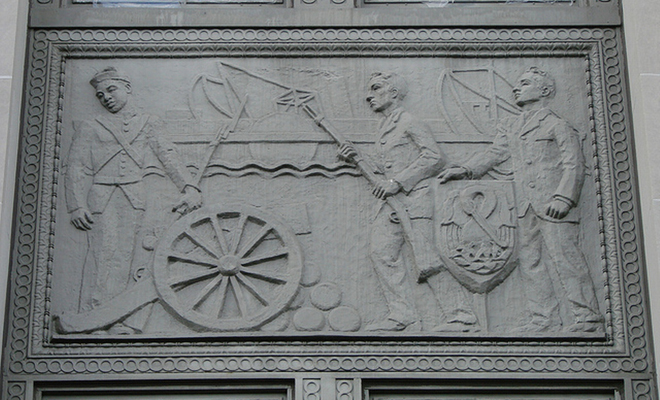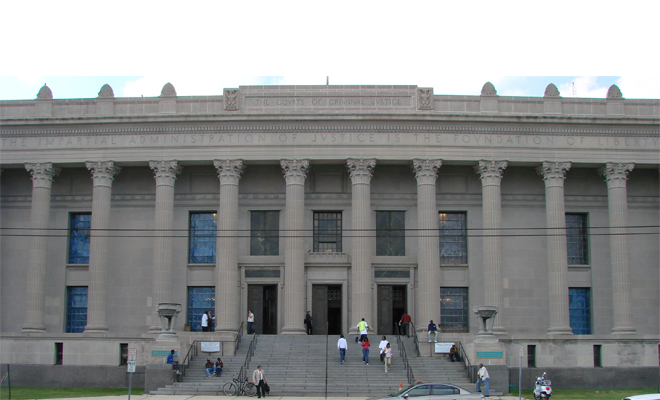The Changing (He)art of New Orleans: Justice in Relief

Cast-iron bronzed bas-reliefs on the Orleans Parish Criminal Court building depict scenes from Louisiana history. Photo by Seth Gaines.
Editor's Note
"The Changing (He)art of New Orleans" examines urban issues at the center of the city through the lens of public art—what is being restored, what is vanishing, and what has already disappeared. Part one focused on two murals in and around the B.W. Cooper housing project as it becomes Marrero Commons and part two recounted the restoration of a WPA mural at a library-turned-yoga-studio on Canal Street. The third installment in this essay series looks at the past and present of the Orleans Parish Criminal Court building.
THIS IS A GOVERNMENT OF LAW NOT OF MEN. The phrase towers over the Broad Street entrance to the Orleans Parish Criminal Court building, flanked by two sharp-nosed pelicans. The words LAW and ORDER stand on either side of no-longer-used doors in art deco block face. On the north side-entrance, the words MERCY and JUSTICE are carved into the limestone. Cast-iron bronzed bas-reliefs stretch below and between the windows depicting scenes from Louisiana history. French trappers navigate up a river toward a Native-American chief. A man in colonial garb stands in front of an ornate gate, fist raised, while soldiers on either side of him brandish a sword and rifle. A solider with broadly rendered African features loads a cannon.
The court’s main entrance fronts Tulane Avenue, the façade stretching for 418 feet. The 12 fluted Corinthian columns face a string of shabby bail bond stores on the other side of Tulane. Abracadabra Bail Bonds: We’ll Get You Out Like Magic.
The beautiful, neoclassical courthouse looms over the core of Mid-City. The long western side of the building is marked by sharp, gray-bright tangles of barbed wire, bulges of new concrete, and trailers, one of which ushers visitors into the OPP complex, which houses some 3,200 inmates on any given day. Presumably, the textual friezes and the historical images used to continue on the other side of the courthouse, constructed between 1929 and 1931, with an adjoining five-story wing for the Orleans Parish Prison, which in the 1930s housed a chapel and an execution chamber. The fact that the building contains some of the most outstanding artistic stone carving in Louisiana—that it is a textbook example of the early 20th-century American architectural renaissance—is a wending narrative of happenstance which takes on painful, ironic undercurrents given the courthouse and OPP’s present status as the block in New Orleans most densely packed with pain.
It is worth thinking about the different meaning that law and order had in 1931, when the carvings were a triumph and portent of future achievement for Angela Gregory, a young and brilliant New Orleans sculptor (1930 New York Sun headline: “Prison Walls Made Less Grim by Girl Sculptor, Who at 25 Executes Many Commissions”). Gregory was the daughter of a Tulane engineering professor and a mother who was an artist trained at Newcomb College’s famous arts-and-crafts-style pottery program. According to Gregory’s personal mythos, she determined to learn stonecutting because of a story her mother told her as a child about the tapping sound of sculptors carving an angel into the face of Newcomb Chapel.
After graduating from Newcomb herself, Angela Gregory received a scholarship to study in Paris but soon went AWOL on her illustrative advertising courses to study under sculptor Antoine Bourdelle, who had himself apprenticed under Rodin. There she made a life-size copy of a famous 15th-century head of Christ (after which, Bourdelle reportedly gave her the keys to his studio) and a clay bust of a visiting young American named Joseph Campbell, who was on a fellowship to study French. “He’s a very nice boy—clean, open face—and rather unusual in that he doesn’t drink and doesn’t smoke,” she wrote her father. “It was indeed amusing to dance with a 20th century youth who has enthusiasm and zest, and talks heatedly about religions and 'what’s beauty?'" The spiritual teacher Jiddu Krishnamurti was sitting for a portrait bust for Bourdelle, and Gregory attended one of his lectures on mysticism and the inter-relatedness of world religions with her friend Joseph—who would go on to become one of the most renowned scholars of myth and comparative religion in the world.
After flying so high in Paris, returning to New Orleans in 1928 was awful for Gregory: “No music, no art. It was hot as Hades. There was nothing. I thought I would go out of my mind.” But the city was in the middle of a period of major redevelopment: the 1880s marine hospital on Tulane and Broad was being torn down and moved uptown to make room for a new and expanded criminal court that would replace the old French-chateau-style building downtown, at the site of the present-day main library branch. Her former professor, impressionist painter Ellsworth Woodward, pulled strings to get his talented and discontented protégé the sculpture commission at the new courthouse. Gregory has written about realizing that if she could focus on work that truly mattered and keep the integrity of her inner life, it did not matter if she was in Paris or New Orleans. She received acclaim for the detailed work at the criminal court, and in coming decades received commissions to work on the state capitol in Baton Rouge and the bronze Bienville monument. Gregory died in 1990, a pillar of the city’s art scene.
This summer, I visited the courthouse’s gilded but worn halls—full of chipped granite stairs, dirty bronze, and newly buffed Tennessee marble—and I paused in front of the small mural her mentor Ellsworth Woodward painted in the lunette above one of the central upstairs courtrooms. Lady Justice stands against a blood-red background, with lengthy quotes about natural law on either side, part of the righteous classicalism that often marks public art from the period. I opened the heavy oak doors: a murder trial was going on inside. Two young men sat at the heavy defense table on the left-hand side of the courtroom, one wearing an ill-fitting suit with ten buttons, each flanked by a lawyer. A drug user from their neighborhood—nearby, on the other side of Tulane—caused a wave of timorous laughter when he addressed the judge informally. Two and a half years ago, the drug user on the bench may have seen one of the young men running from the scene after his murdered fixer didn’t show up to meet him. A police detective with close-cropped hair asked about the blood on the drug dealer’s cell phone, found at the scene . . .

Detailed pelicans appear throughout the courthouse exterior. Photo by Seth Gaines.
According to architectural surveys of the building, the courtrooms originally had elaborate coffered ceilings and classical pilasters and plaster cornices (plans occasionally circulate to restore these). That has now all been covered over in favor of the muted chloroform aesthetic that pervades modern criminal courts. As I listened to the testimony and watched the young men avoid eye contact with one another, I looked around at the muted blue-grays, the off-white, and rows of small light fixtures along the dull lacquered wooden siding. According to the Times-Picayune’s series, “Louisiana Incarcerated,” there are 5,000 black men from New Orleans currently in the state prison and only 400 local white men. The disparity is just as keen at the parish prison level. It can be difficult for members of the New Orleans white community to fully wrap their minds around the extent to which judicial procedure and incarceration are facts of life in low-income black neighborhoods where the police disproportionately conduct drug raids.
In “Never Fight a Shark in Water,” a one-man show created by journalist Lara Naughton and former prisoner Gregory Bright, Bright describes going to visit friends from the nearby Calliope (or B.W. Cooper) projects at the prison as a teenager. He speaks of the stench of fear and pain that pervaded the air around the courthouse and prison. At age 20, he was himself arrested for murder on weak evidence—the shaky testimony of a heroin addicted neighbor. Spending the night in jail for the first time at OPP, Bright felt tainted, as though that stench had gotten into him, and forever wanted him back. He would spend 27 and a half years in prison before being cleared of all charges at age 47. In the three decades Bright was incarcerated, Louisiana's total prison population climbed from just over 6,000 to more than 36,000.
Bright uses musical backing throughout “Never Fight a Shark in Water”: the '70s funk and soul hits from his formative pre-incarceration teenage years. Telling his life story now, at times the slim, slightly wizened 54-year-old shuffles his feet back and forth in a joyful mock-swagger to the groove.
In New Orleans, one in seven black men is incarcerated, on probation, or on parole—and the proportion surpasses 60 percent in some neighborhoods. Louisiana has the highest incarceration rate in the world. The stench Bright describes is still palpable for thousands across the city, particularly low-income black men and their families. It radiates from Tulane and Broad, and pervades the blighted blocks between Tulane and Banks as well as the shell of the Calliope projects on the other side of I-10, which is being converted into mixed-income housing. That is also where the parish prison extension that heavily flooded during Katrina—with abandoned inmates inside—is being rebuilt, to house about 1,400 and augment the current OPP complex behind the courthouse, a process that is beset with controversy. The federal Department of Justice has roundly criticized the parish prison for the presence of roaches, rats, terrible food sanitation, lacking mental health, constant assaults, and callous, violent guards.
Last April I listened as a family made their way out from the magistrate’s courtroom, where the state had determined there was enough evidence to move forward with a murder charge for a young man who is accused of being involved in a drive-by shooting at the B.W. Cooper that killed a little girl. The family talked amongst themselves about the years that it will take for his charge to be processed. As they made their way down the court’s wide, impressive steps—about six or eight people, including a heavy-set woman, a teenager with Mr. Tee tattooed on her arm holding a little girl, a quiet man with a beard—a woman who had been in the courtroom for another case caught them: “I heard y’all got first degree—and I just wanted to say, I’m praying for you.”
Legal scholar Michelle Alexander has calculated that nationwide, more blacks are presently incarcerated than were enslaved in the United States at the peak of the plantation regime. Incarceration is so woven into Louisiana’s policies and infrastructure—OPP and the courthouse seem such a permanent part of the heart of New Orleans—that it can be impossible to imagine a time when the system will be different. Above the family towered the Roman letters Angela Gregory carved above the front of the court more than 80 years ago when New Orleans’ population was 140,000 people larger than it is today and Orleans Parish Prison housed only 800 inmates: THE IMPARTIAL ADMINISTRATION OF JUSTICE IS THE FOUNDATION OF LIBERTY.

Carvings on the courthouse face read: THE IMPARTIAL ADMINISTRATION OF JUSTICE IS THE FOUNDATION OF LIBERTY. Photo by Seth Gaines.



